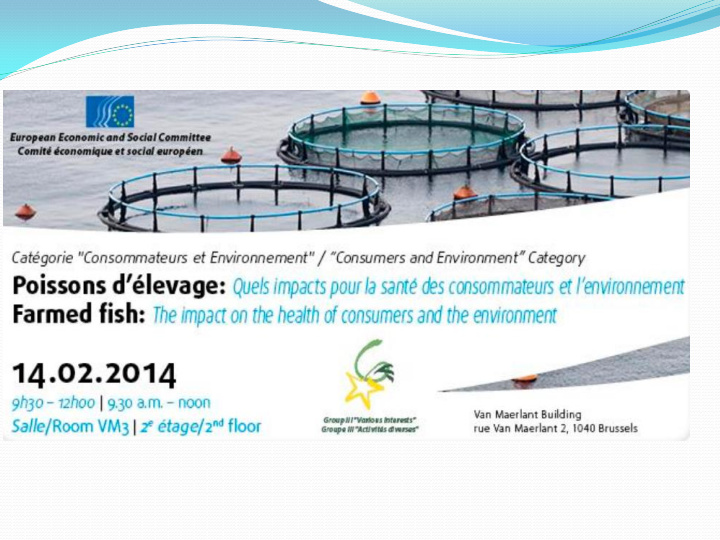



Five Fundamental Flaws of Sea Cage Salmon Farming #1 Wastes #2 Escapes #3 Diseases/Parasites #4 Chemicals #5 Feed/Food
The Fatal Flaw: #5 FEED/FOOD “Intensive sea cage fish farming’s dependence upon a fast diminishing and increasingly contaminated resource – namely fish meal and fish oil – threatens to blow sea cage fish farming out of the water altogether. The fifth fundamental flaw – the unresolved and unsolvable feed/food issue - will ultimately be the final fatal flaw for sea cage fish farming” (2002 to European Parliament)
Fish Farmageddon? “European consumers are alarmed by recent media reports which claim that aquaculture fishery products may not be safe. The environmental damage of fish farming is a further concern for European citizens. There are also claims of fish farms being accused of spreading diseases to wild fish and of discharging waste and pesticides into the sea”
Don Staniford Director of Protect Wild Scotland: director@protectwildscotland.org Global Co-ordinator of the Global Alliance Against Industrial Aquaculture (GAAIA): dstaniford@gaaia.org
Big Fish in Little Pond 5% of world’s food fish in 1970 ca. 50% in 2013 (62% by 2030) Consumer of 80%+ of world’s fish oil Huge ecological footprint: “Robbing Pedro to Pay Paul” Bigger & bigger farms: “Super - Size Salmon Farming”
Norway’s “ Salmonopoly ”
Biological Agent NOT Indicator of Pollution Shellfish farming traditionally viewed as a biological indicator of pollution (i.e. canary in the coalmine) Salmon farming now viewed as a biological agent of pollution (i.e. self- pollution; “salmon harming”)
Problem Not Panacea Salmon farming is part of the problem; not a panacea for the world food problem or crisis in world fisheries Salmon farming drains the world’s oceans Salmon farming bio-accumulates contaminants Farmed salmon should be labelled as hazardous waste not healthy food! Salmon farming should be banned!
Science Has Spoken
Weight of Scientific Evidence
Dr Claudette Bethune “Farmed salmon is a toxic dump site where the most toxic forms of fat soluble pollutants accumulate”
Environmental & Public Health WARNING!
Five Fundamental Flaws of Sea Cage Salmon Farming #1 Wastes #2 Escapes #3 Diseases/Parasites #4 Chemicals #5 Feed/Food
#1 Wastes/Effluent “Solution to Pollution is NOT Dilution” Scottish salmon farming = wastes equivalent of 10 million people (Scotland’s population is 5 million) Norwegian salmon farming – waste equivalent of 70 million people (14 x Norway’s population!) NOT a drop in the ocean
#1 Wastes Scottish salmon farming = effluent from 10 million people (twice Scotland’s population) Norwegian salmon farming = effluent from 70 million people (14 times Norway’s population) Nitrogen, phosphorus, copper, zinc, waste feed, toxic chemicals, mortalities etc
#2 Escapes Genetic Pollution Via Interbreeding “Extinction Vortex” in Wild Salmon 25% of Scottish ‘wild’ salmon are of Norwegian origin (i.e. Farmed) Escapees = 90%+ of ‘wild’ fish in some Norwegian rivers 2 million escapees in Scotland since 2002 2.5 million in Norway EVERY YEAR!
#3 Diseases/Parasites Sea Lice Infectious Salmon Anaemia (ISA) Amoebic Gill Disease (AGD) Heart & Skeletal Muscle Inflammation (HSMI) Pancreas Disease (PD) Salmonella Listeria
Marine Protected Areas Need to Be Bigger! “We found a clear correlation between lice levels on wild salmonids and lice production in nearby salmon farms....The capacities of the smallest fjords of withstanding lice infection from fish farms are probably limited. It is therefore reasonable to assume that the protection of large areas contributes best to ensure the protection of wild salmon”
#4 Chemicals Antibiotics (e.g. Oxytetracycline) Antiparasitics (e.g. Azamethiphos) Artificial Colourings (e.g. Canthaxanthin) Antifoulants (e.g. Copper) Feed Ingredients (e.g. Ethoxyquin) Feed Contaminants (e.g. DDT, PCBs, Toxaphene, Dioxins, Chlordane, Dieldrin, Cadmium, Lead etc)
Chemical Culture Chemical Resistance/Arms Race: The Drugs Don’t Work! Increasing Use/Older Toxic Chemicals Synergistic/Cocktail Effect “Marine Pollutants” Carcinogenic/Mutagenic Sea-Bed Contamination “Silent Spring of the Sea”
Five Fundamental Flaws Wastes - “solution to pollution is not dilution” Escapes - “genetic pollution” and “extinction vortex” Diseases – sea lice, ISA, Piscine Reovirus etc Chemicals – toxic “marine pollutants” FEED/FOOD – depleted and contaminated
#5 Feed/Food Net Loss of Protein 5 tons of wild fish = 1 ton of farmed salmon “Biological Nonsense”/“Tiger of Sea” “Robbing Pedro to Pay Paul” Myth of “Feeding the World” “The Greed of Feed” Land Animal Protein & GM Feed
Fish Feed: Depleted & Contaminated Aquaculture already uses over 80% of the world’s fish oil: now even krill in Antarctica DG SANCO: Fish from the Northern Hemisphere 8 x more contaminated than Southern Hemisphere Salmon Farming is Unsustainable & Unhealthy
Between the Devil & the Deep Blue Sea - Contaminated Feed Vs Genetically Modified
GM Salmon & GM Feed AquaBounty trials in Scotland in the 1990s Approval by the US & Canada GM soya & maize in Chilean salmon farming GM feed in Norwegian salmon farming? GM vegetables with Omega 3s
Fishing Down Food Chain Dr Daniel Pauly of University of British Columbia: “We are going to farm the fish we need. But there is a hitch: salmon and many other farmed fish are carnivorous, and farming them involves feeding them with animal flesh, just as farming mountain lions would. In this case, the animal flesh, supplied in the form of pellets, consists of ground up sardines, anchovies, mackerels and other edible fish caught mainly - you guessed it - in developing countries. About 3-4 pounds of ground up small fishes are required to produce one pound of farmed salmon. Thus, the more farmed fish we produce, the less fish there is. This is akin to robbing Pedro to pay Paul”
“Feeding aquaculture in an era of finite resources” (2009) “The ratio of wild fisheries inputs to farmed fish output has fallen to 0.63 for the aquaculture sector as a whole but remains as high as 5.0 for Atlantic salmon”
Recommend
More recommend